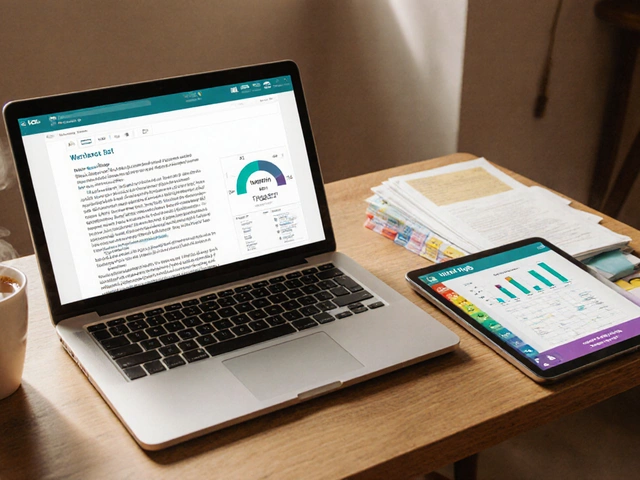There are 600 million blogs out there, but most won't last even a year. People jump in all fired up, but before long, their posts dry up and their audience disappears. Sound familiar? It's a common story—in fact, over 80% of new blogs go silent before their first birthday.
Why do so many bloggers flop? A big piece of the puzzle is picking the wrong blogging platform. It’s easy to get tempted by something free or flashy, only to find it’s a hassle to use or limits how you grow. Sometimes, people spend more time wrestling with tech than actually writing. Ever tried switching to a new platform after you start? It’s a nightmare for most. Imagine moving years of posts and losing half your traffic in the process.
But mistakes go beyond the platform. New bloggers underestimate the grind. They expect instant readers, but real growth takes time and constant effort. It's easy to quit when nobody reads your stuff for months. If you want any chance at building an audience, picking the right blogging platform that matches your plans is step one you can't afford to skip.
- Biggest Missteps New Bloggers Make
- The Pressure of Platform Choices
- Consistency: The Silent Killer
- Money Talk: Realistic Earning vs. Reality
- The Technical Headache Nobody Warns You About
- Turning the Stats Around
Biggest Missteps New Bloggers Make
The hype is real, but most first-timers crash and burn fast—and it’s usually not for lack of passion. Let’s talk turkey about why so many people who chase blog growth end up disappointed.
First off, the single biggest mistake is chasing perfection over progress. People get caught up tweaking their blog’s look for weeks, fussing over logos and fonts, but never actually hit 'publish.' The ones who win? They post, learn, and tweak as they go.
Another killer is picking topics that don’t last. Most folks grab a trending idea—keto diets, crypto, whatever’s hot that week. The problem? These trends fizzle fast, leaving blogs with nothing useful to say. Evergreen topics might sound boring, but they bring steady traffic month after month.
Then, there’s the ‘write it and they will come’ myth. New bloggers wait for readers to magically show up, but the truth is, nobody cares unless you put yourself out there. You have to promote your blog like you mean it—on social, in forums, through email, and by commenting on related sites. Sitting back means staying invisible.
Some jump into fancy platforms that are way too complicated or expensive, thinking it’ll make them look more legit. But that just leads to frustration. Choosing the right blogging platform should match your tech skills and what you really need, not what the pros use. If you’re writing about baking for busy moms, you don’t need the same setup as a tech review site.
- Inconsistent posting: Publishing three posts one week, then nothing for two months. Readers lose interest fast.
- No clear niche: Blogging about random topics confuses readers and search engines. Pick a focus and stick with it.
- Ignoring SEO basics: Not adding keywords, headers, or meta descriptions? Google will ignore you.
- Quitting too early: Most blogs see barely any traffic in the early months—it’s normal. Growth is painfully slow at first but pays off later.
Check out this eye-opener from a 2024 WordPress survey:
| Reason for Blog Failure | Percentage |
|---|---|
| Lack of Consistency | 38% |
| Poor Topic Choice | 22% |
| Technical Frustration | 17% |
| Lack of Promotion | 14% |
| Burnout | 9% |
If you focus on regular, useful content and choose the right blogging platforms from the start, you’re already moving ahead of the pack. Avoid these common traps if you want to dodge the ‘dead blog’ pile.
The Pressure of Platform Choices
Picking the right blogging platform can make or break your blogging journey. People usually get stuck here because the range of choices is dizzying—WordPress (both .com and .org), Wix, Squarespace, Substack, Medium… each has its own quirks. If you're new, it's easy to grab onto the first free signup that looks easy, but that can backfire, big time.
Here's the thing: what works for one blogger might be a terrible fit for another. For example, WordPress.org is the world's most popular platform (it powers over 40% of all websites), and it gives you endless control. But you need to handle hosting, updates, and the ugly side of tech problems. Wix and Squarespace are smoother to use—drag, drop, and you’re rolling—but you get less customization, and scaling up can get expensive as your blog growth kicks in.
- If you want to focus on writing, Medium or Substack let you skip tech headaches, but you’re bound by their rules and algorithms. If they change the rules, you’re stuck.
- If you care about real control and building something for the long haul, a self-hosted platform like WordPress.org is the gold standard—even if it means a tougher learning curve.
Still not sure what to choose? Look at the numbers:
| Platform | Easy Setup | Customization | Monthly Cost (basic) |
|---|---|---|---|
| WordPress.org | No | High | $4–$10 (hosting) |
| Squarespace | Yes | Medium | $16–$23 |
| Wix | Yes | Medium | $14–$18 |
| Medium | Yes | Low | Free/$5 (membership) |
| Substack | Yes | Low | Free (with fee on paid subs) |
Thinking long term matters for beginner bloggers. Are you okay growing inside someone else's sandbox, or do you want your blog to be all yours, even as your blog growth explodes? Plenty of blogging failure stories start right here, with an early platform choice that wasn't a good match. Before you sign up, get real about what you want from your blog—and how much tech stuff you’re willing to put up with.
Consistency: The Silent Killer
Let’s be real: most beginner bloggers start off with big plans, posting like crazy for a couple of weeks. But then life happens, motivation fades, and suddenly that blog is collecting dust. It’s the slow fade—skipping just one week, planning to come back, but suddenly months have gone by. Consistency is what quietly wipes out the majority of new blogs.
Data backs this up. Recent surveys say less than 10% of new bloggers manage to keep up a weekly posting schedule after the first three months. Those who stick to a regular posting pattern—even just once a week—are way more likely to build an audience and get traction with blog growth.
Why does consistency matter so much? Simple: search engines love fresh content. If your posts are spaced months apart, you’ll never rank high. Readers are the same; if they never know when you’ll post, they won’t bother coming back. Consistency builds trust.
- Plan Ahead: Use an editorial calendar. Free tools like Trello or Google Sheets work great for mapping out posts and tracking progress.
- Batch-Write: Knock out multiple posts in one session. That way, you’re covered when things get busy.
- Keep it Realistic: If you can’t blog daily, don’t even try. Start with once a week or even once every two weeks. The key is sticking to it.
If you think nobody will notice if you skip a week, you’re wrong. Check out how consistency affects blog stats:
| Posting Frequency | Avg. Monthly Visits (After 6 Months) |
|---|---|
| Weekly | 1,800 |
| Fortnightly | 950 |
| Monthly | 400 |
This table says it all. Blogs with weekly updates quickly outpace the rest. So if you care about blogging failure and want to avoid it, making a habit of sticking to your schedule is half the battle won.

Money Talk: Realistic Earning vs. Reality
Almost every new blogger hopes to earn real money, but here’s the bitter pill—most never do. There’s a massive gap between the dream (making a cool $10,000 a month) and what actually winds up in your pocket. According to a 2024 survey by ProBlogger, over 70% of active bloggers make less than $500 a year. That's not enough for a fancy coffee each week, let alone quitting your job.
The problem is simple: people see giant paychecks posted on social media, but they don’t see the years of hard work behind them. Most beginner bloggers think you post a few times and instantly have ad companies begging for space. In reality, earning takes time, traffic, and the right blogging platform that actually lets you monetize. Some free platforms don’t even let you run ads or use affiliate links, so you have to switch (which can be a mess) if you ever get big enough to make money.
Here's a quick reality check on how earnings look for typical bloggers:
| Monthly Visitors | Average Monthly Earnings |
|---|---|
| <1,000 | $0 - $10 |
| 1,000 - 10,000 | $10 - $200 |
| 10,000 - 100,000 | $200 - $2,000 |
| >100,000 | $2,000 and up |
To get into the big leagues, you need steady traffic—thousands of visitors each month. That takes solid content, smart SEO, consistent blog growth, and serious patience. A lot of bloggers quit before hitting the tipping point because nothing happens quickly. If you want to actually pay bills from blogging, remember:
- Choose a blogging platform that lets you earn money in the way you want—ads, affiliates, digital sales, whatever.
- Be patient, and set real timelines. Six months of posting is normal before your traffic even starts climbing.
- Learn from bloggers actually earning, not just showing off. Real income posts always break down costs and traffic sources.
- Avoid platforms that take a cut or make it hard to move your blog somewhere better if you outgrow them.
It’s easy to dream, harder to execute. But knowing how little most bloggers make can save you from overhyped promises and disappointment down the line.
The Technical Headache Nobody Warns You About
Here's the deal: blogging platforms aren't all made equal, and the tech side can make or break your blog way faster than you'd expect. Most people think writing is the hardest part, but honestly, tech issues send more beginners packing than writer's block ever could. If you pick the wrong platform, you'll find yourself stuck Googling terms like 'plugin conflict,' 'server downtime,' or '404 errors' way more than you actually post.
Let's face it, not everyone starts out as a web whiz. On self-hosted platforms like WordPress.org, you're in charge of updates, backups, dealing with hosting problems, and fighting off spam comments. Mess up a single setting and your blog could go offline or get hacked. Wix or Squarespace sound easier, but even there, you'll hit walls trying to customize things beyond basic templates.
Want cold hard numbers? According to a recent survey by Statista, about 27% of bloggers quit because of technical challenges—more than those discouraged just by lack of traffic. That's a lot of people heading for the exit just because tech headaches get too much.
| Platform | Average Setup Time (hours) | Beginner-Friendly |
|---|---|---|
| WordPress.org | 5+ | No |
| Wix | 1 | Yes |
| Squarespace | 2 | Yes |
| Blogger | 1 | Yes |
The real struggle? Many popular blogging platforms throw a lot of hidden tasks your way. Plugins need updates, themes break, site speed tanks—often without any warning. And if your blog picks up speed, cheap hosting can buckle under traffic spikes, making your site crash right when you finally get your big break. Not fun.
Here are some tips to keep the tech headaches under control:
- Start simple. Platforms like Blogger or Wix get your posts online with the least fuss. Upgrade later if you outgrow them.
- Keep backups. Don’t trust your platform to save your work—save it yourself, once a week at least.
- Learn the basics. No need to become a coder, but knowing how to troubleshoot or restore a backup goes a long way.
- Don’t load up on plugins and extras you don’t need—every extra adds another thing that can break.
- Watch out for costs. Some platforms lure you in cheap, then hit you with add-on fees or force you to upgrade plans just to get tech support.
The sooner you face the technical side head-on, the sooner you can focus on what matters most: actually writing your blog and reaching your readers.
Turning the Stats Around
If most bloggers fail, then what separates the ones who actually stick around and see real results? It’s less about luck and more about fixing the basics you can control—especially your platform and workflow. Let’s break down what actually works for those who beat the odds and get *seen*, not forgotten.
Start with your choice of blogging platforms. Platforms like WordPress.org, Ghost, and Wix aren’t just popular for show. WordPress.org runs almost 43% of the web because it gives you freedom, plugins, and SEO tools you literally can’t beat with most free options. If you want growth and not just a digital diary, you need a platform you won’t outgrow in a year.
Next, make a habit out of content. The numbers don’t lie—blogs posting at least once a week get 3.5 times more traffic than those that don’t. Most folks fail because they go in without a posting schedule. Treat your blog like a business, not a hobby, and your results will follow.
- Set a realistic posting schedule (once a week beats five posts in a flurry and then silence).
- Pick a topic you actually care about. If you’re bored writing it, people will be bored reading it.
- Don’t panic over zero readers in month one—keep at it. It can take 6-12 months for Google to notice new sites.
- Focus on building an email list from day one. Social traffic dips, email followers stick with you.
Another huge power move? Study what successful blogs in your niche are doing. Analyze their content types, read the comments to see what readers care about, and don’t be shy about tweaking your approach to match what actually works. Don’t copy—adapt.
Here’s a quick comparison of what helps top blogs grow versus what typically fails:
| What Fails | What Works |
|---|---|
| Random topics | Niche focus |
| Irregular posting | Consistent schedule |
| Ignoring SEO | Keyword research |
| Using only free platforms | Invest in scalable platforms |
In the end, those who turn things around were usually the ones who stuck it out, adjusted when things weren’t working, and chose platforms built for blog growth. If you do the same, you’ll already be beating the 80% who bowed out early.






Written by Arjun Mitra
I am an IT consultant with a keen interest in writing about the evolution of websites and blogs in India. My focus is on how digital spaces are reshaping content creation and consumption. I aim to provide insights and strategies for those looking to thrive in the digital landscape.
All posts: Arjun Mitra